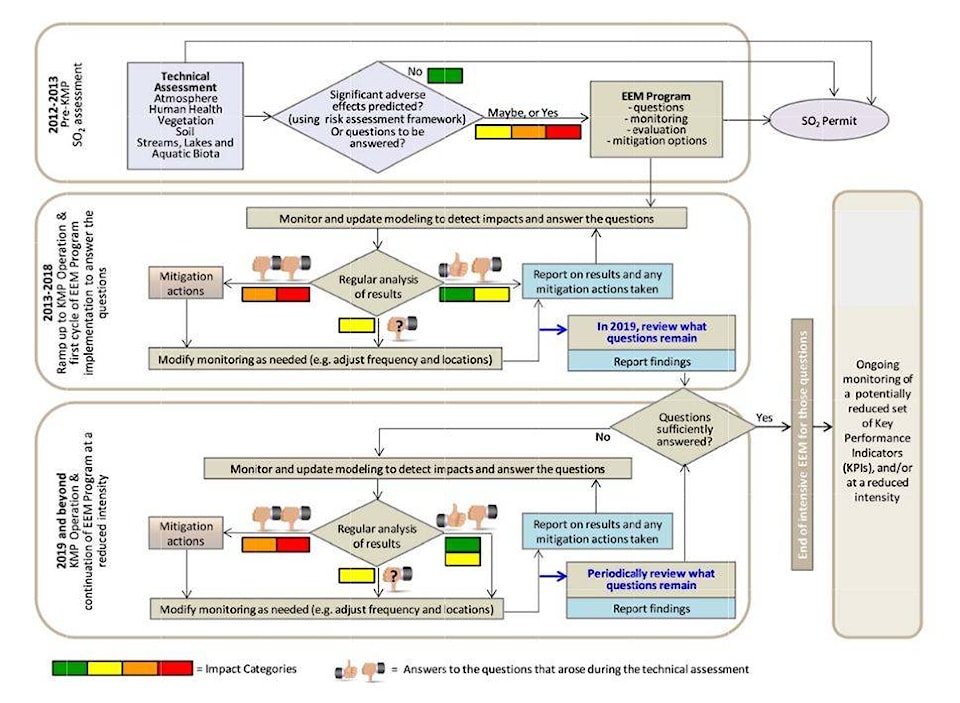The District of Kitimat council has signalled its intent to participate in the 2019 review of the Rio Tinto’s sulphur dioxide monitoring plan.
The Environmental Effects Monitoring Plan (EEMP) was a condition of the approval by the provincial government in April 2013, for the increase in Rio Tinto’s allowable emissions of sulphur dioxide (SO2) to 42 metric tons per day.
The previous limit of a maximum daily discharge of 27 metric tons of SO2 was set in 1999 and needed to be increased to allow for the expansion of Rio Tinto’s BC Works through the Kitimat Modernization Project (KMP), as per an application submitted by Rio Tinto Alcan in 2007.
The EEMP was submitted to the Ministry of Environment’s northern region director and was approved nearly 18 months after the permit amendment was granted.
In a letter approving the EEMP issued in the fall of 2014 the ministry set out key performance indicators that stipulated thresholds in relation to the impact on vegetation, soil and water. No thresholds were set out in relation to human health though.
“The health section of the EEM program and key performance indicators (KPI) will be updated when provincially applied SO2 ambient air quality guidelines come into effect,” reads the EEMP document available on Rio Tinto’s website.
The review is an opportunity for potential changes to be made to the terms of the EEMP, based on input received from parties involved in the review.
The motion for the DoK to participate in the review was submitted by councillor Rob Goffinet at last week’s council meeting.
“[I move that] the District of Kitimat, in the interest of maintaining and improving the highest possible standards of air quality in Kitimat air shed, commits to work with BC Ministry of Environment, Rio Tinto Alcan, Haisla First Nation, and other interested community groups as an active and involved participant in the Environmental Effects Monitoring (EEM) program, including 2019’s Comprehensive EEM Program Review,” read Goffinet’s motion.
Speaking to the motion, Goffinet said the DoK’s participation in the review was not only important for the future of aluminium, but also to the development of the LNG industry in Kitimat.
“With this motion we would be free to take part in as an intense way as we want in preparation for our concerns and needs being addressed when this EEM program is comprehensively reviewed in 2019,” said Goffinet.
He said in the last year of the EEM current program that started in 2014, the district needed to be “extra vigilant, be an integral part and put our concerns and needs in front of the program.”
“It is designed in the next year to evaluate the concerns of the district and the community, as to [whether] this program delivered the highest quality air in the Kitimat airshed,” said Goffinet.
Councillor Mario Feldhoff, supporting the motion, said the review would be a good forum on which to raise concerns about the airshed and the environment and “what appropriate action should be, including possible scrubber installation”.
“The EEM is not static and was always designed for periodic review, which is exactly what is coming up in 2019.
The forum ensures that the science and all conflicting points of view are appropriately considered.”
He said members of the community had expressed concern over SO2 and believed that the DoK should be an active and involved participant in a comprehensive review.
Mayor Phil Germuth said if the intent of the motion was to change the EEM going forward, he would support the motion.
He questioned the wording of the motion, with particular reference to the phrase “in the interest of maintaining and improving the highest possible standards of air quality”.
“Maintaining means we are already there, that we are OK with where we are, when clearly the vast majority of this community would like to see it improve,” said Germuth.
He added that if the district wanted to look at changing the scope of the EEM program to be able to look at mitigating the effects of high levels of SO2, he would support the motion. A lengthy debate around the wording led to two amendments to the motion, the first being the changing of the words “maintaining and improving” to “attaining and maintaining”.
Germuth suggested a second amendment to the motion to have a staff member and budget assigned to the review.
Both amendments were approved and the motion was passed unanimously by council.
